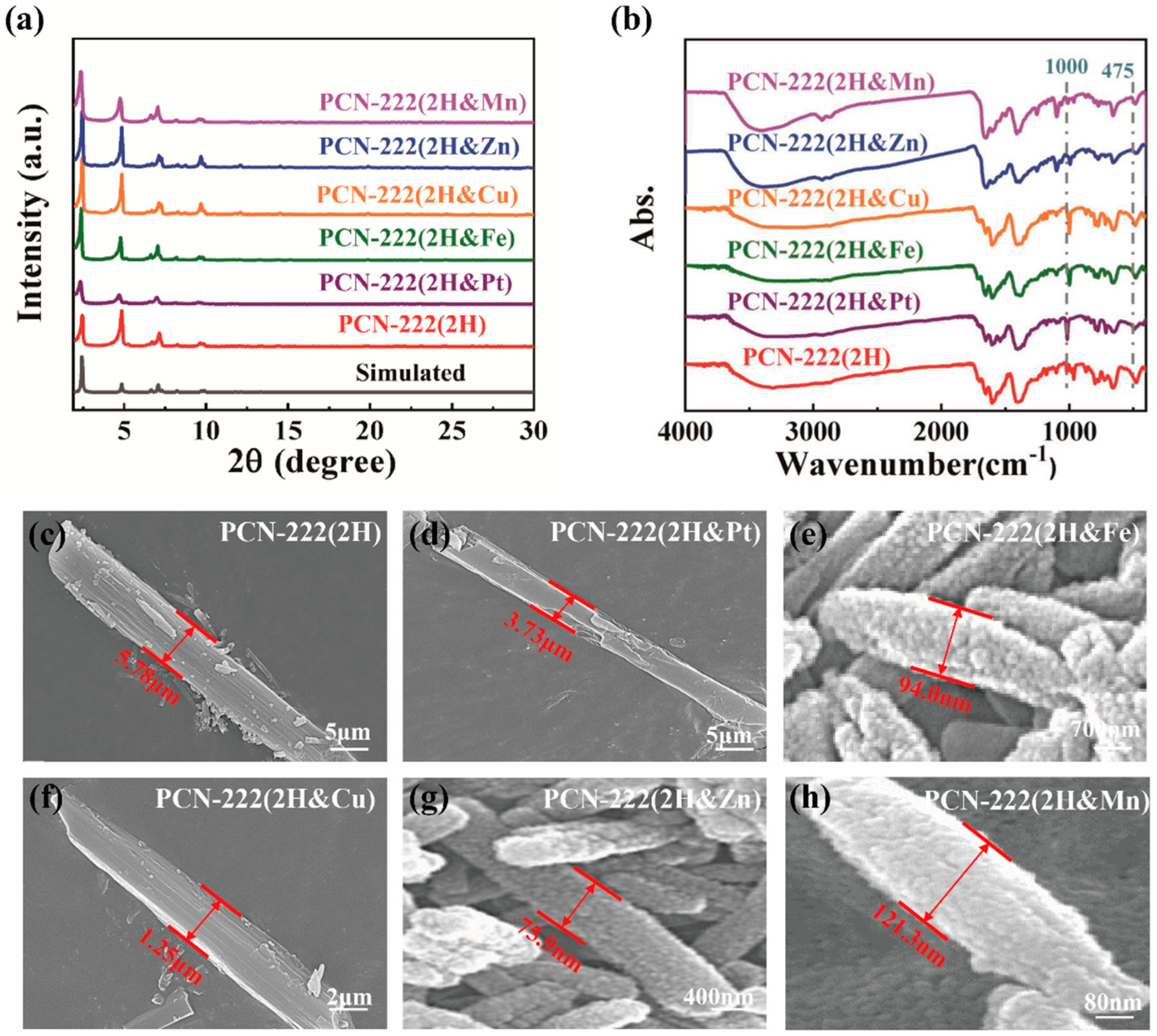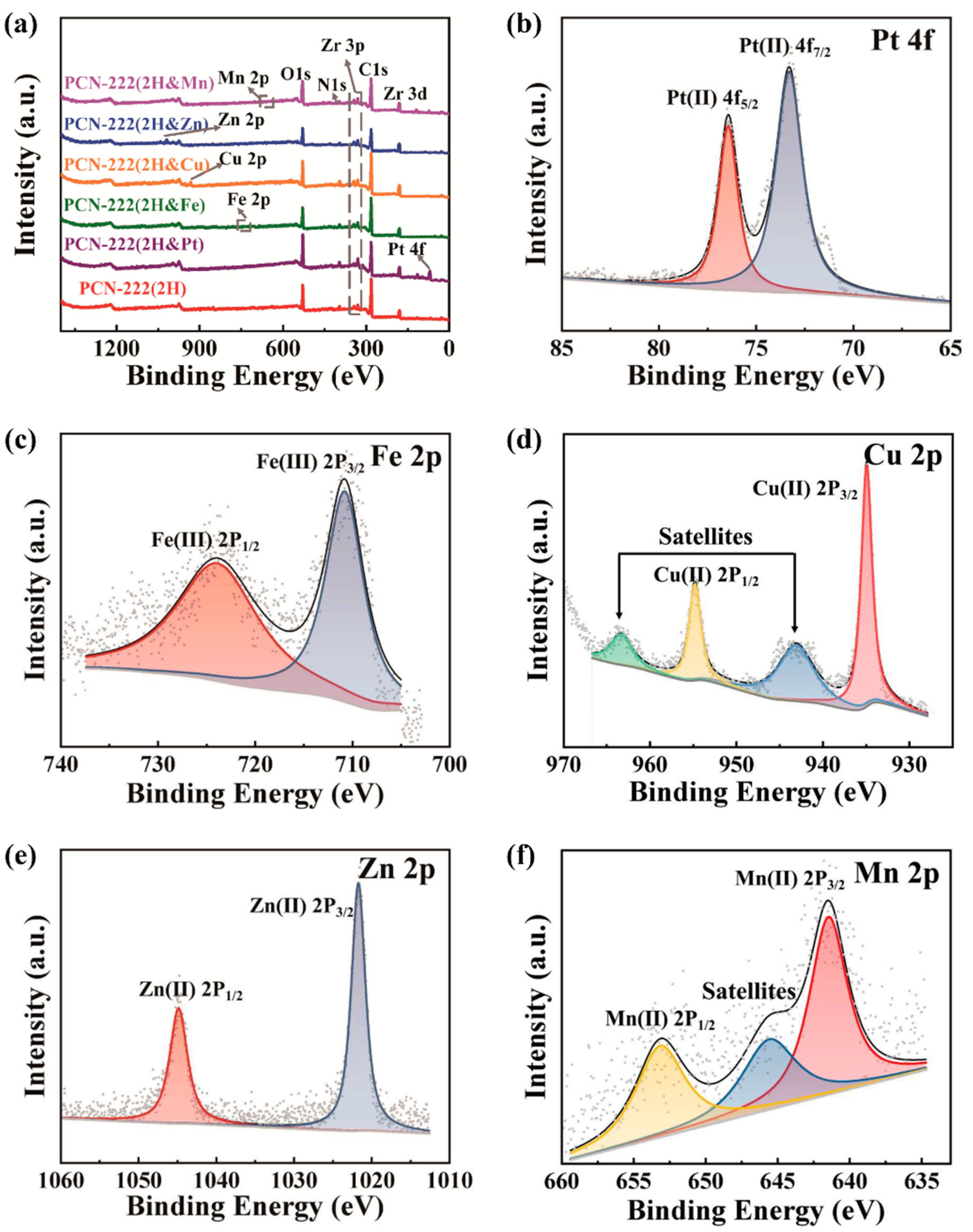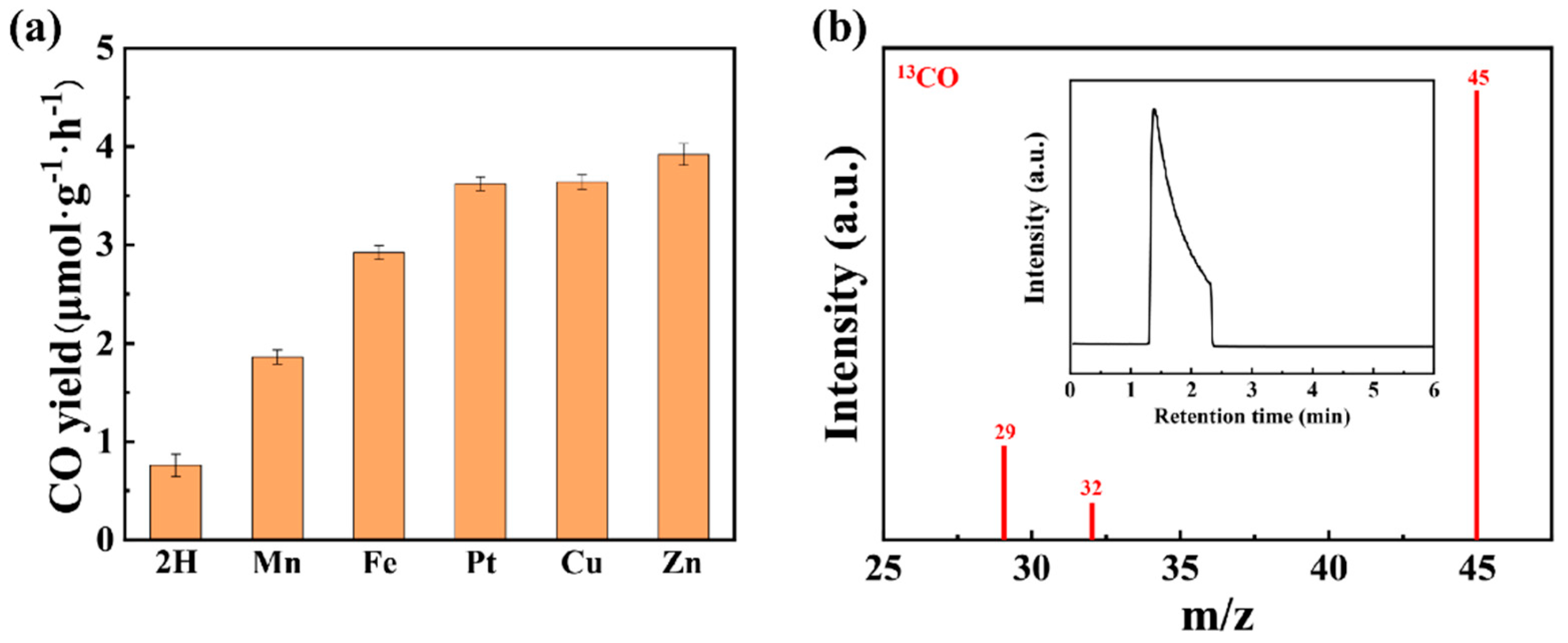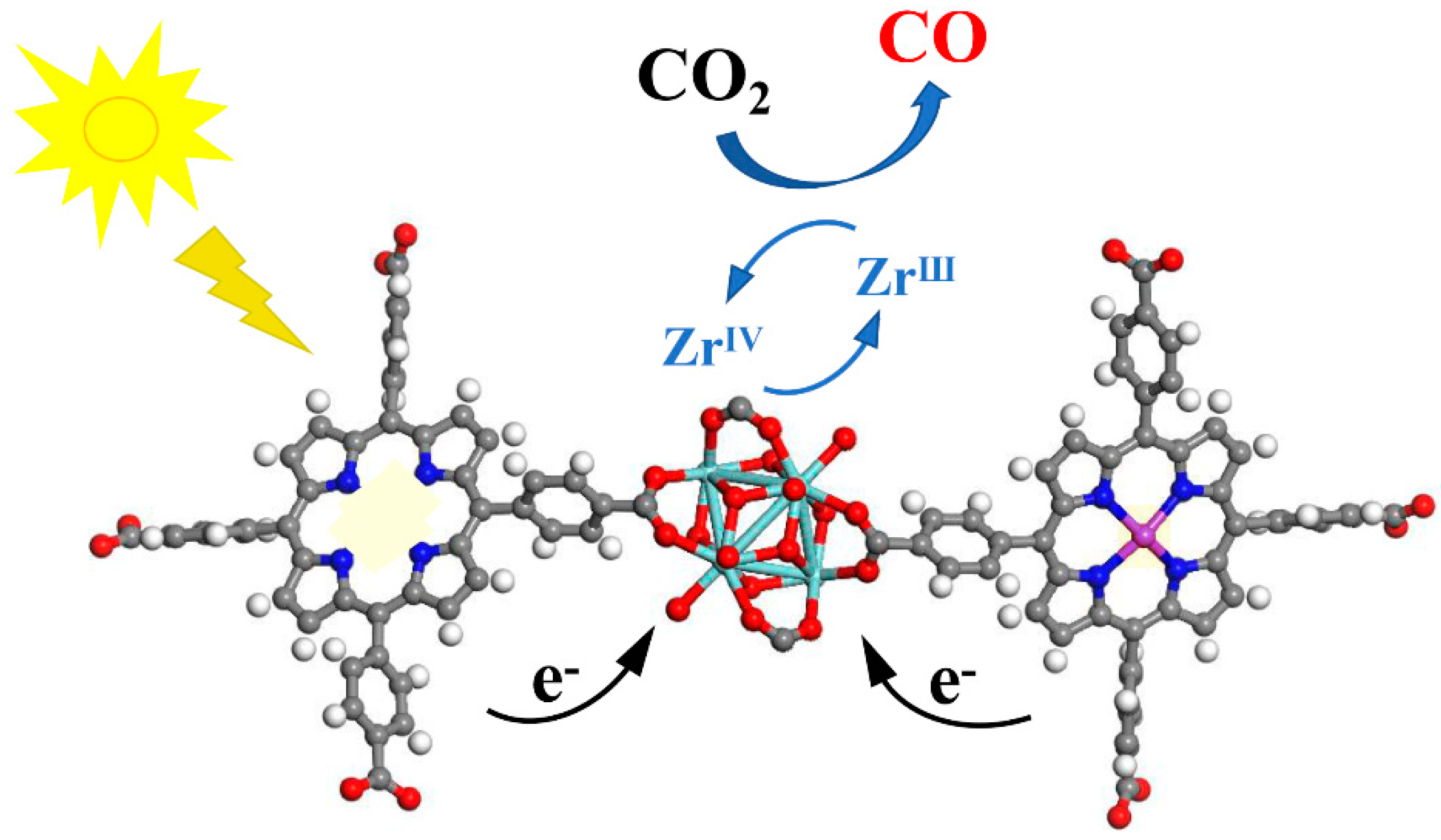Metalloporphyrin-Based Metal–Organic Frameworks for Photocatalytic Carbon Dioxide Reduction: The Influence of Metal Centers
Abstract
1. Introduction
2. Materials and Methods
2.1. Materials
2.2. Synthesis of PCN-222(2H), PCN-222(Zn), and PCN-222(2H&M)
2.3. Characterizations
2.4. Photoelectrochemical Performance
2.5. Photocatalytic Activity
3. Results and Discussion
3.1. Characterization of Catalysts
3.2. Photocatalytic CO2RR Performance of PCN-222 Materials
3.3. Photocatalytic Mechanism Analysis
4. Conclusions
Supplementary Materials
Author Contributions
Funding
Acknowledgments
Conflicts of Interest
References
- Song, J.; Lu, Y.; Lin, Y.; Liu, Q.; Wang, X.; Su, W. A direct Z-scheme α-Fe2O3/LaTiO2N visible-light photocatalyst for enhanced CO2 reduction activity. Appl. Catal. B Environ. 2021, 292, 120185. [Google Scholar] [CrossRef]
- Li, X.; Liu, H.; Luo, D.; Li, J.; Huang, Y.; Li, H.; Fang, Y.; Xu, Y.; Zhu, L. Adsorption of CO2 on heterostructure CdS(Bi2S3)/TiO2 nanotube photocatalysts and their photocatalytic activities in the reduction of CO2 to methanol under visible light irradiation. Chem. Eng. J. 2012, 180, 151. [Google Scholar] [CrossRef]
- Hiragond, C.; Ali, S.; Sorcar, S.; In, S. Hierarchical Nanostructured Photocatalysts for CO2 Photoreduction. Catalysts 2019, 9, 370. [Google Scholar] [CrossRef]
- Wang, K.; Cao, M.; Lu, J.; Lu, Y.; Lau, C.H.; Zheng, Y.; Fan, X. Operando DRIFTS-MS investigation on plasmon-thermal coupling mechanism of CO2 hydrogenation on Au/TiO2: The enhanced generation of oxygen vacancies. Appl. Catal. B Environ. 2021, 296, 120341. [Google Scholar] [CrossRef]
- Karmakar, S.; Barman, S.; Rahimi, F.A.; Maji, T.K. Covalent grafting of molecular photosensitizer and catalyst on MOF-808: Effect of pore confinement toward visible light-driven CO2 reduction in water. Energy Environ. Sci. 2021, 14, 2429–2440. [Google Scholar] [CrossRef]
- Wang, G.; Chen, J.; Ding, Y.; Cai, P.; Yi, L.; Li, Y.; Tu, C.; Hou, Y.; Wen, Z.; Dai, L. Electrocatalysis for CO2 conversion: From fundamentals to value-added products. Chem. Soc. Rev. 2021, 50, 4993. [Google Scholar] [CrossRef]
- Jiang, X.; Nie, X.; Guo, X.; Song, C.; Chen, J.G. Recent Advances in Carbon Dioxide Hydrogenation to Methanol via Heterogeneous Catalysis. Chem. Rev. 2020, 120, 7984–8034. [Google Scholar] [CrossRef]
- Alshorifi, F.T.; Alswat, A.A.; Mannaa, M.A.; Alotaibi, M.T.; El-Bahy, S.M.; Salama, R.S. Facile and Green Synthesis of Silver Quantum Dots Immobilized onto a Polymeric CTS-PEO Blend for the Photocatalytic Degradation of p-Nitrophenol. ACS Omega 2021, 6, 30432–30441. [Google Scholar] [CrossRef]
- Alshorifi, F.T.; Ali, S.L.; Salama, R.S. Promotional Synergistic Effect of Cs–Au NPs on the Performance of Cs–Au/MgFe2O4 Catalysts in Catalysis 3,4-Dihydropyrimidin-2(1H)-Ones and Degradation of RhB Dye. J. Inorg. Organomet. Polym. Mater. 2022, 32, 3765–3776. [Google Scholar] [CrossRef]
- Alshorifi, F.T.; Alswat, A.A.; Salama, R.S. Gold-selenide quantum dots supported onto cesium ferrite nanocomposites for the efficient degradation of rhodamine B. Heliyon 2022, 8, e09652. [Google Scholar] [CrossRef]
- Lei, Z.; Xue, Y.; Chen, W.; Qiu, W.; Zhang, Y.; Horike, S.; Tang, L. MOFs-Based Heterogeneous Catalysts: New Opportunities for Energy-Related CO2 Conversion. Adv. Energy Mater. 2018, 8, 1801587. [Google Scholar] [CrossRef]
- Zhang, Z.; Zhu, Y.; Chen, X.; Zhang, H.; Wang, J. A Full-Spectrum Metal-Free Porphyrin Supramolecular Photocatalyst for Dual Functions of Highly Efficient Hydrogen and Oxygen Evolution. Adv. Mater. 2019, 31, 1806626. [Google Scholar] [CrossRef]
- Taniguchi, M.; Lindsey, J.S. Synthetic Chlorins, Possible Surrogates for Chlorophylls, Prepared by Derivatization of Porphyrins. Chem. Rev. 2017, 117, 344–535. [Google Scholar] [CrossRef]
- Li, J.; Zhao, Y.; Wang, X.; Wang, T.; Hou, X. Rapid microwave synthesis of PCN-134-2D for singlet oxygen based-oxidative degradation of ranitidine under visible light: Mechanism and toxicity assessment. Chem. Eng. J. 2022, 443, 136424. [Google Scholar] [CrossRef]
- Leng, F.; Liu, H.; Ding, M.; Lin, Q.; Jiang, H. Boosting Photocatalytic Hydrogen Production of Porphyrinic MOFs: The Metal Location in Metalloporphyrin Matters. ACS Catal. 2018, 8, 4583–4590. [Google Scholar] [CrossRef]
- Li, P.; Zhang, X.; Hou, C.; Chen, Y.; He, T. Highly efficient visible-light driven solar-fuel production over tetra(4-carboxyphenyl)porphyrin iron (III) chloride using CdS/Bi2S3 heterostructure as photosensitizer. Appl. Catal. B Environ. 2018, 238, 656–663. [Google Scholar] [CrossRef]
- Wang, L.; Jin, P.; Duan, S.; She, H.; Huang, J.; Wang, Q. In-situ incorporation of Copper(II) porphyrin functionalized zirconium MOF and TiO2 for efficient photocatalytic CO2 reduction. Sci. Bull. 2019, 64, 926–933. [Google Scholar] [CrossRef]
- Wang, Z.; Jiao, X.; Chen, D.; Li, C.; Zhang, M. Porous Copper/Zinc Bimetallic Oxides Derived from MOFs for Efficient Photocatalytic Reduction of CO2 to Methanol. Catalysts 2020, 10, 1127. [Google Scholar] [CrossRef]
- Credico, B.D.; Redaelli, M.; Bellardita, M.; Calamante, M.; Cepek, C.; Cobani, E.; D’Arienzo, M.; Evangelisti, C.; Marelli, M.; Moret, M.; et al. Step-by-Step Growth of HKUST-1 on Functionalized TiO2 Surface: An Efficient Material for CO2 Capture and Solar Photoreduction. Catalysts 2018, 8, 353. [Google Scholar] [CrossRef]
- Kitao, T.; Zhang, Y.; Kitagawa, S.; Wang, B.; Uemura, T. Hybridization of MOFs and polymers. Chem. Soc. Rev. 2017, 46, 3108. [Google Scholar] [CrossRef]
- Zhao, T.; Wu, H.; Wen, X.; Zhang, J.; Tang, H.; Deng, Y.; Liao, S.; Tian, X. Recent advances in MOFs/MOF derived nanomaterials toward high-efficiency aqueous zinc ion batteries. Coord. Chem. Rev. 2022, 468, 214642. [Google Scholar] [CrossRef]
- Gao, X.; Liu, B.; Zhao, X. Thiol-decorated defective metal-organic farmework for effective removal of mercury(II) ion. Chemosphere 2023, 317, 137891. [Google Scholar] [CrossRef] [PubMed]
- Gong, X.; Noh, H.; Gianneschi, N.C.; Farha, O.K. Interrogating Kinetic versus Thermodynamic Topologies of Metal–organic frameworks via Combined Transmission Electron Microscopy and X-ray Diffraction Analysis. J. Am. Chem. Soc. 2019, 141, 6146–6151. [Google Scholar] [CrossRef] [PubMed]
- Sarker, M.; Shin, S.; Jeong, J.H.; Jhung, S.H. Mesoporous metal-organic framework PCN-222(Fe): Promising adsorbent for removal of big anionic and cationic dyes from water. Chem. Eng. J. 2019, 371, 252–259. [Google Scholar] [CrossRef]
- Xu, H.; Hu, J.; Wang, D.; Li, Z.; Zhang, Q.; Luo, Y.; Yu, S.; Jiang, H. Visible-Light Photoreduction of CO2 in a Metal-Organic Framework: Boosting Electron-Hole Separation via Electron Trap States. J. Am. Chem. Soc. 2015, 137, 13440–13443. [Google Scholar] [CrossRef]
- Zhang, A.; Si, D.; Huang, H.; Xie, L.; Fang, Z.; Liu, T.; Cao, R. Partial Metalation of Porphyrin Moieties in Hydrogen-Bonded Organic Frameworks Provides Enhanced CO2 Photoreduction Activity. Angew. Chem. Int. Ed. 2022, 61, e202203955. [Google Scholar]
- Jin, J. Highly stable and efficient visible-light-driven carbon dioxide reduction by zirconium-metalloporphyrin PCN-222 via dual catalytic routes. React. Kinet. Mech. Catal. 2020, 131, 397–408. [Google Scholar] [CrossRef]
- Moghaddam, Z.S.; Kaykhaii, M.; Khajeh, M.; Oveisi, A.R. PCN-222 metal-organic framework: A selective and highly efficient sorbent for the extraction of aspartame from gum, juice, and diet soft drink before its spectrophotometric determination. BMC Chem. 2020, 14, 19. [Google Scholar] [CrossRef]
- Guo, Y.; Zhang, X.; Xie, N.; Guo, R.; Wang, Y.; Sun, Z.; Li, H.; Jia, H.; Niu, D.; Sun, H. Investigation of antimony adsorption on a zirconium-porphyrin-based metal–organic framework. Dalton Trans. 2021, 50, 13932. [Google Scholar] [CrossRef]
- Hariri, R.; Dehghanpour, S. Adsorptive removal and visible-light photocatalytic degradation of large cationic and anionic dyes induced by air-bubbles in the presence of a magnetic porphyrinic metal-organic framework (Fe3O4@SiO2@PCN-222 (Fe)). J. Phys. Chem. Solids 2021, 155, 110126. [Google Scholar] [CrossRef]
- Gao, L.; Hu, X.; Qin, S.; Chu, H.; Zhao, X.; Wang, B. L-Cysteine modified metal–organic framework as a chiral stationary phase for enantioseparation by capillary electrochromatography. RSC Adv. 2022, 12, 6063–6075. [Google Scholar]
- Wang, R.; Fan, Y.; Wang, L.; Wu, L.; Sun, S.; Sun, S. Pt nanocatalysts on a polyindole-functionalized carbon nanotube composite with high performance for methanol electrooxidation. J. Power Sources 2015, 287, 341–348. [Google Scholar] [CrossRef]
- Han, B.; Yu, S.; Wang, Z.; Zhu, H. Imidazole polymerized ionic liquid as a precursor for an iron-nitrogen-doped carbon electrocatalyst used in the oxygen reduction reaction. Int. J. Hydrog. Energy 2020, 45, 29645–29654. [Google Scholar] [CrossRef]
- Huang, G.; Su, T.; Zeng, K.; Guo, Y.; Zhao, S.; Wei, S. Mesoporous chitosanimmobilized iron tetrakis(4-carboxyphenyl)porphyrin as a model of cytochrome P-450 enzyme for oxidation of ethylbenzene. Appl. Organomet. Chem. 2018, 32, e4140. [Google Scholar] [CrossRef]
- Chung, N.T.K.; Dang, H.P.; Nguyen, T.P.; Le, T. Effects of Zn and Zn–N doping on optical, electrical, and structural properties of p-type SnO2 films. J. Photochem. Photobiol. A Chem. 2021, 418, 113436. [Google Scholar] [CrossRef]
- Zhang, Y.; Zhang, Y.; Huang, Y.; Jia, Y.; Chen, L.; Pan, Y.; Wang, M. Adsorptive-photocatalytic performance and mechanism of Me (Mn, Fe)-N co-doped TiO2/SiO2 in cyanide wastewater. J. Alloy. Compd. 2021, 867, 159020. [Google Scholar] [CrossRef]
- Shi, L.; Yang, L.; Zhang, H.; Chang, K.; Zhao, G.; Kako, T.; Ye, J. Implantation of Iron (III) in Porphyrinic Metal Organic Frameworks for Highly Improved Photocatalytic Performance. Appl. Catal. B Environ. 2018, 224, 60–68. [Google Scholar] [CrossRef]
- Liu, D.; Cai, W.; Wang, Y.; Zhu, Y. Constructing a novel Bi2SiO5/BiPO4 heterostructure with extended light response range and enhanced photocatalytic performance. Appl. Catal. B Environ. 2018, 236, 205–211. [Google Scholar] [CrossRef]
- Qin, J.; Xiao, Z.; Xu, P.; Li, Z.; Lu, X.; Yang, X.; Lu, W.; Ma, L.; Li, D. Anionic Porous Zn-Metalated Porphyrin Metal-Organic Framework with PtS Topology for Gas-Phase Photocatalytic CO2 Reduction. Inorg. Chem. 2022, 61, 13234–13238. [Google Scholar] [CrossRef]
- Jin, J. Porphyrin-based metal-organic framework catalysts for photoreduction of CO2: Understanding the effect of node connectivity and linker metalation on activity. New J. Chem. 2020, 44, 15362. [Google Scholar] [CrossRef]
- Duan, S.; Wu, S.; Wang, L.; She, H.; Huang, J.; Wang, Q. Rod-Shaped Metal Organic Framework Structured PCN-222(Cu)/TiO2 Composites for Efficient Photocatalytic CO2 Reduction. Wuli Huaxue Xuebao 2020, 36, 19050861–19050868. [Google Scholar]
- Wang, L.; Jin, P.; Huang, J.; She, H.; Wang, Q. Integration of Copper(II)-Porphyrin Zirconium Metal-Organic Framework and Titanium Dioxide to Construct Z-Scheme System for Highly Improved Photocatalytic CO2 Reduction. ACS Sustain. Chem. Eng. 2019, 7, 15660. [Google Scholar] [CrossRef]
- Fang, Z.; Liu, T.; Liu, J.; Jin, S.; Wu, X.; Gong, X.; Wang, K.; Yin, Q.; Liu, T.; Gao, R.; et al. Boosting Interfacial Charge-Transfer Kinetics for Efficient Overall CO2 Photoreduction via Rational Design of Coordination Spheres on Metal-Organic Frameworks. J. Am. Chem. Soc. 2020, 142, 12515. [Google Scholar] [CrossRef]
- Sun, D.; Fu, Y.; Liu, W.; Ye, L.; Wang, D.; Yang, L.; Fu, X.; Li, Z. Studies on Photocatalytic CO2 Reduction over NH2-UiO-66(Zr) and Its Derivatives: Towards a Better Understanding of Photocatalysis on Metal–organic frameworks. Chem. Eur. J. 2013, 19, 14279. [Google Scholar] [CrossRef] [PubMed]
- Li, J.; Huang, H.; Xue, W.; Sun, K.; Song, X.; Wu, C.; Nie, L.; Li, Y.; Liu, C.; Pan, Y.; et al. Self-adaptive dual-metal-site pairs in metal-organic frameworks for selective CO2 photoreduction to CH4. Nat. Catal. 2021, 4, 719. [Google Scholar] [CrossRef]
- Hariri, R.; Dehghanpour, S. Effective visible-light CO2 photoreduction over (metallo) porphyrin-based metal–organic frameworks to achieve useful hydrocarbons. Appl. Organomet. Chem. 2021, 35, e6422. [Google Scholar] [CrossRef]








Disclaimer/Publisher’s Note: The statements, opinions and data contained in all publications are solely those of the individual author(s) and contributor(s) and not of MDPI and/or the editor(s). MDPI and/or the editor(s) disclaim responsibility for any injury to people or property resulting from any ideas, methods, instructions or products referred to in the content. |
© 2023 by the authors. Licensee MDPI, Basel, Switzerland. This article is an open access article distributed under the terms and conditions of the Creative Commons Attribution (CC BY) license (https://creativecommons.org/licenses/by/4.0/).
Share and Cite
Li, Q.; Wang, K.; Wang, H.; Zhou, M.; Zhou, B.; Li, Y.; Li, Q.; Wang, Q.; Shen, H.-M.; She, Y. Metalloporphyrin-Based Metal–Organic Frameworks for Photocatalytic Carbon Dioxide Reduction: The Influence of Metal Centers. Processes 2023, 11, 1042. https://doi.org/10.3390/pr11041042
Li Q, Wang K, Wang H, Zhou M, Zhou B, Li Y, Li Q, Wang Q, Shen H-M, She Y. Metalloporphyrin-Based Metal–Organic Frameworks for Photocatalytic Carbon Dioxide Reduction: The Influence of Metal Centers. Processes. 2023; 11(4):1042. https://doi.org/10.3390/pr11041042
Chicago/Turabian StyleLi, Qian, Keke Wang, Heyu Wang, Mengmeng Zhou, Bolin Zhou, Yanzhe Li, Qiang Li, Qin Wang, Hai-Min Shen, and Yuanbin She. 2023. "Metalloporphyrin-Based Metal–Organic Frameworks for Photocatalytic Carbon Dioxide Reduction: The Influence of Metal Centers" Processes 11, no. 4: 1042. https://doi.org/10.3390/pr11041042
APA StyleLi, Q., Wang, K., Wang, H., Zhou, M., Zhou, B., Li, Y., Li, Q., Wang, Q., Shen, H.-M., & She, Y. (2023). Metalloporphyrin-Based Metal–Organic Frameworks for Photocatalytic Carbon Dioxide Reduction: The Influence of Metal Centers. Processes, 11(4), 1042. https://doi.org/10.3390/pr11041042







